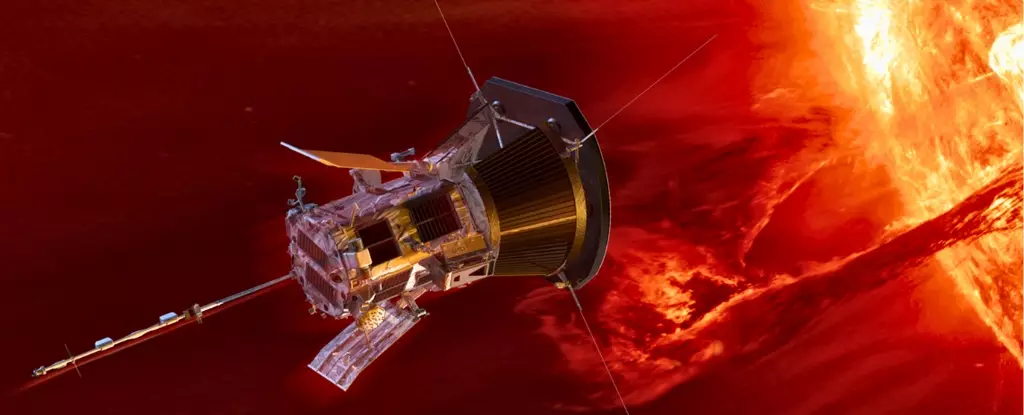In August 2018, humanity took a monumental leap forward with the launch of NASA’s Parker Solar Probe (PSP), a groundbreaking mission designed to delve into the enigmatic nature of the Sun’s outer corona. This spacecraft is not just a machine; it is a symbol of our relentless curiosity and commitment to understanding the cosmos. Since its launch, the Parker Solar Probe has embarked on a series of gravity-assist maneuvers around Venus, steadily inching closer to the Sun and ultimately shattering existing records for proximity to our celestial star.
On October 29, 2018, the Parker Solar Probe achieved a significant milestone by becoming the closest human-made object to the Sun, surpassing the record set by Helios 2. With each gravity assist, the spacecraft has ventured deeper into the solar atmosphere, culminating in its closest approach on December 24, 2024. At this momentous occasion, the probe skimmed just 6 million kilometers (around 3.8 million miles) above the solar surface, marking a stunning achievement in the field of astrophysics. This distance is equivalent to approximately 0.04 astronomical units (AU), underscoring the scale of our closest stellar neighbor.
During these close encounters, the Parker Solar Probe achieved staggering speeds of approximately 692,000 km/h (or 430,000 mph), making it the fastest human-made object in history. At this velocity, it travels at about 0.064% of the speed of light—a testament to the technological prowess involved in its design and operation.
One of the most remarkable aspects of the Parker Solar Probe is its ability to withstand the extreme conditions presented by the solar corona. To achieve this, engineers designed an innovative carbon foam shield capable of enduring temperatures ranging between 980 to 1,425 degrees Celsius (1,800 to 2,600 degrees Fahrenheit). This cutting-edge thermal protection not only shields the probe from the searing heat of the Sun but also ensures that onboard instruments remain at a stable temperature, allowing them to function effectively in the harsh solar environment.
The significance of the Parker Solar Probe’s mission extends well beyond its technical achievements. As rightly stated by Nicky Fox, Associate Administrator for NASA’s Science Mission Directorate, the probe’s ambitious goal is to unlock insights into solar behavior that have far-reaching consequences for our technology and daily lives.
The Parker Solar Probe’s mission has already unveiled unexpected phenomena that challenge long-standing assumptions about the Sun. Its initial pass through the corona in 2021 revealed a landscape characterized by an unexpected topography of spikes and valleys, raising new questions about the dynamics of the solar atmosphere. Additionally, the probe has played a pivotal role in elucidating the origins of switchbacks—zig-zag structures within the solar wind. Each close encounter provides invaluable data that enhances our understanding of solar activities and their implications for space weather affecting Earth and the broader solar system.
Moreover, the Parker Solar Probe has helped paint a more detailed picture of space weather phenomena. The spacecraft has documented solar wind interactions that directly influence the environment of various planets, including Earth. This knowledge is crucial for developing protective measures against potentially harmful solar activity that can disrupt satellite communications and power grids.
Impact on Planetary Studies: Insights Beyond the Sun
The PSP’s influence extends far beyond solar studies; its exploration of Venus during gravity assist maneuvers has yielded fascinating insights about our nearest neighbor. The probe has captured images of Venus and has documented its radio emissions, contributing to our understanding of this intriguing planet. Such findings are crucial for comparative studies of planetary atmospheres, aiding in the greater quest to understand potential habitability on planets beyond our solar system.
Each solar pass contributes new information about the intricacies of solar wind acceleration as it departs the Sun. Mission scientist Adam Szabo highlights that this close proximity allows researchers to gather data that may hold the key to one of solar physics’ most enduring mysteries.
Looking Ahead: The Next Phase of Discovery
As the Parker Solar Probe continues its historic journey, its scientific team is prepared for further solar passes, with significant encounters planned for March 22, 2025, and June 19, 2025. The anticipation for the data that will follow these encounters is palpable. As Joe Westlake, director of NASA’s Heliophysics Division, emphasizes, this mission represents a remarkable accomplishment, propelling us further into a realm where human understanding and cosmic mysteries intermingle.
In essence, the Parker Solar Probe is redefining our approach to solar research and deepening our comprehension of the fundamental forces that govern our solar system. As it ventures ever closer to the Sun, it prepares to unveil secrets that humanity has long sought to understand, marking a new era in space exploration.


Leave a Reply